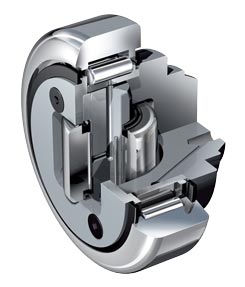
Combined Bearings
Combined bearings are high-precision bearing systems that provide high positioning accuracy and maximum resistance against dirt for heavy-duty applications in the building material industry, foundry, mining industry, etc.
We offer a wide range of combined bearings such as axial bearings eccentric adjustable, intended for high temperature, bearings adjustable with OILAMID insert, bearings with combined bolts, radial bearings, bearings for heavy-duty industry, and more.
HVH Industrial works with manufacturers' specialized engineering teams to meet our customers' requirements and highest quality standards.
If you have any questions, write us via live chat (one of our team members will answer your questions), give us a call, or send us a quote request. The HVH team is always ready to help you.
 1(866)577-4040
1(866)577-4040
or
Combined Bearings
Manufacturers
Combined bearings are an integral component of many heavy-duty applications, offering a high level of precision, positioning accuracy, and exceptional resistance against dirt and other contaminants. These specialized bearing systems play a crucial role in various industries, enabling smooth and reliable operation in challenging environments. In this article, we will explore the features, benefits, and applications of combined bearings, highlighting their significance in modern industrial machinery.
What are Combined Bearings
Combined bearings, also known as combination bearings, are mechanical devices that combine the characteristics of two or more types of bearings. By incorporating different bearing types into a single unit, combined bearings offer improved performance and load-carrying capabilities, making them highly desirable in many industries.
A typical combined bearing consists of inner and outer rings, rolling elements, cages, and in some cases, seals or shields. The inner and outer rings provide structural support and act as raceways for the rolling elements. These rings are usually made of high-quality steel or other suitable materials, depending on the application requirements.
The rolling elements can vary depending on the specific combination of bearing types. They can include ball bearings, roller bearings, needle bearings, or a combination thereof. The choice of rolling elements depends on factors such as load capacity, rotational speed, and desired operational characteristics.
To ensure smooth operation and minimize friction, combined bearings incorporate cages or separators that maintain a precise distance between the rolling elements. Integrated seals protect against contaminants, ensuring long-term durability.
Features and Advantages of Combined Bearings
Combined bearings offer several notable features and benefits that make them indispensable in heavy-duty applications. Let's explore some of these key advantages:
High Positioning Accuracy
One of the primary advantages of combined bearings is their exceptional positioning accuracy. They allow for precise control of movements and ensure that machinery operates within tight tolerances. This level of accuracy is crucial in applications where precise positioning and alignment are required, such as robotics, automated handling systems, and CNC machines.
Maximum Resistance Against Dirt
Heavy-duty applications often involve exposure to dirt, dust, and other contaminants. Combined bearings are designed to withstand these harsh conditions, providing maximum resistance against dirt and other particulates. The integrated seals act as a barrier, preventing the ingress of contaminants into the bearing system. This feature enhances the longevity of the bearings and reduces the risk of premature failure.
Durability and Longevity
Combined bearings are engineered to withstand heavy loads, shocks, and vibrations, making them highly durable. The combination of robust construction and high-quality materials ensures their longevity even in demanding environments. By choosing combined bearings, industrial machinery owners can minimize downtime and maintenance costs associated with frequent bearing replacements.
Reduced Maintenance Costs
The durability and reliability of combined bearings translate into reduced maintenance costs. These bearings require less frequent maintenance interventions and replacements compared to conventional bearing systems. This advantage contributes to improved productivity and cost-effectiveness for businesses relying on heavy-duty machinery.
Applications of Combined Bearings
Combined bearings find extensive applications across various industries that demand high precision, durability, and load-carrying capabilities. Here are some notable applications:
Construction and Heavy Machinery
Combined bearings play a vital role in construction machinery such as excavators, bulldozers, and cranes. They provide reliable support and smooth motion in the pivotal joints and lifting mechanisms of these heavy machines.
Material Handling Systems
In material handling systems like conveyors and forklifts, combined bearings facilitate the movement of heavy loads with precision and efficiency. They enable smooth operation, reducing the risk of jams and ensuring optimal productivity.
Robotics and Automation
The precision and load-bearing capacity of combined bearings makes them ideal for robotics and automation applications. They enable precise control of robotic arms and other moving components, ensuring accurate positioning and reliable performance.
Packaging and Processing Equipment
Combined bearings are widely used in packaging and processing equipment, such as filling machines, labeling machines, and conveyor systems. They ensure smooth and reliable movement, contributing to the efficiency of these operations.
Conclusion
Combined bearings are essential components in heavy-duty applications, providing high precision, positioning accuracy, and maximum resistance against dirt. These bearings offer significant advantages such as durability, reduced maintenance costs, and enhanced load-carrying capabilities. From construction machinery to robotics and wind turbines, combined bearings find extensive applications across diverse industries.




